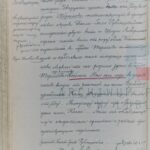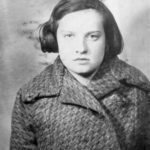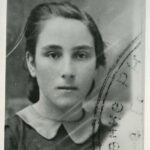The three children of Berl Fayvel Goldsztern and Yocheved Rozenzumen who stayed in Poland rather than emigrating were destined for annihilation by the Nazis. This post focuses on Uszer (Asher) Goldsztern and his family.
Uszer was one of the middle children of Berl Fayvel Goldsztern and Yocheved Rozenzumen. He was born in 1881 in Terespol in what was then “Russian Poland.” My grandfather Sol told me that Uszer had 11 children, was religious and that his wife’s name was Dvorah. As it turns out, that information was mostly correct; however, Sol did not tell me any of the children’s names.
Using the JRI-Poland site (Jewish Records Indexing-Poland) through JewishGen.org, I have been able to access records of the Polish State Archives (“ASC”). Metrical (vital) records more than 100 years old are held in this archive; records less than 100 years old are held at the municipal level and are subject to privacy laws. In this way I found Uszer’s 1881 birth registration:
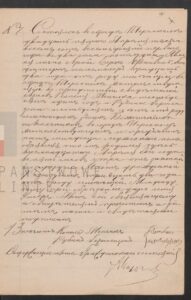
Akt* #7. In the city of Terespol, on the 25th of April 1881, at 2 pm. Jew Berko Fayvel Goldstern, weaver, 32 years old, residing in the city of Terespol, appeared in person, in the presence of witnesses, Jews Kopel Monchik, 61 years old, and Rubin Hershenson, 60 years old, residing in the city of Terespol, and presented a baby boy to us, announcing that he was born on the 18th of April of this year at 5 am, from his legal spouse Yachvet, born Rozensumen, 32 years old. This baby boy is given a name Usher at the time of circumcision. This act is announced and read to witnesses, and then signed.Kopel Monchik (signature); Rubin Hershenson (signature); Civilian registry office clerk (signature). (*”Akt” means record)
I also found his marriage registration from July 16, 1899, but the marriage was to Esther Brandla Cham, not to Dvorah. It was only when I later hired Tadeusz Przystojecki, a Polish researcher from the Lublin area, that this discrepancy was resolved.
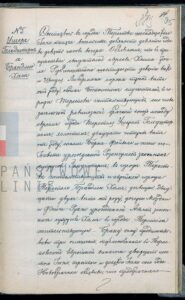
Akt #5. In the town of Terespol, on July 16th 1899, at 9:00 pm, it is announced that in the presence of witnesses, Jew Haim Yoel Rubinstein, 69 year old, and Shmul Liberman, 43 years old, both religious attendants residing in the town of Terespol, a religious marriage was contracted between the Jew of Terespol town, Usher Goldstern, single, 24 years old**, son of Berko Fayvel and his spouse Yachet, born Rosenzumen, legal spouses Goldstern residing in the town of Terespol, and a Jew of Terespol town, single lady Brandla Cham, 22 years old, daughter of Mordka and Feigy Ruchli born Atlas, legal spouses Cham in the town of Terespol. This marriage was preceded by three announcements published at Terespol Jewish synagogue on June 26, July 3 and July 10 of this year.
**If Uszer was born in 1881, how could he have been 24 years old in 1899? It is not unusual to see such discrepancies in documents, or perhaps the translators of either the birth or marriage document erred. This is easy to do as the records were hand-written. However, birth registrations for his subsequent confirm the older age, so perhaps the translator mis-read the year of Uszer’s birth or it was registered incorrectly. Again, not an uncommon happenstance.
I found birth registrations for three sons born to Uszer and Brandla, the first being Chaim David in April 1897. You’ve probably noticed that the marriage was in 1899 but Chaim David was born two years earlier in 1897; it was not uncommon for births to be registered later than the actual date of birth.
Akt #40. Registered in Terespol July 15, 1899, born April 4, 1897, of Chaim Dawid GOLDSZTERN son of Uszer, 24 and Ester Brandla nee CHAM, 22.
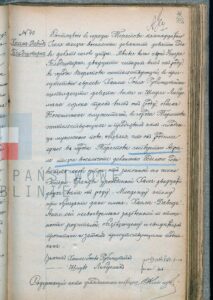
Chaim David was, indeed, born two years prior to the marriage, and his birth was only registered the day before his parents got married. Clearly, Uszer and Brandla were not married when Chaim David was born.
Hiding in these documents is an interesting story; we can’t know exactly what happened, but one can imagine all kinds of scenarios. There seems to have been an out-of-wedlock birth, perhaps the parents were against the marriage and it took two years to convince them, perhaps Uszer was away during that time – drafted? conducting business? – perhaps something else we can’t even imagine.
Nevertheless, they married and had children and then the story went in a heartbreaking direction. In May 8, 1902, twins Noech (Noah) and Szmuel were born to Uszer and Brandla:
Birth Akt 21. Registered in Terespol May 15, born May 8, 1902, of twin Noach Goldsztern son of Uszer, 26 and Brajndla nee Cham, 24.
Birth Akt 22. Registered in Terespol 15 May 1902, born in Terespol, 8 May 1902, of twin Szmul Goldsztern. Father: Uszer Goldsztern, 26 years of age, resident of town Terespol, Mother: Brandla nee Cham, 24 years of age.
Researcher Tadeusz Przystojecki found the document that provided answers and revealed a tragedy, because eight months after their birth, on January 13, 1903, Uszer married Dvorah Ruchla Segal:
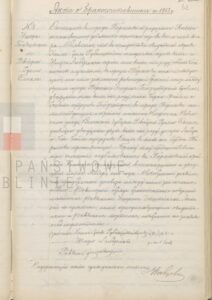
Akt 1. Uszer Goldsztern and Dwojra Ruchla Segal. Registered in Terespol, 13 Jan 1903, Married in Terespol, 13 Jan 1903. Groom: Uszer Goldsztern (27), widower, son of Berek Fajwel and Jochwet, spouses Goldsztern. Bride: Dwojra Ruchla Segal (22), single, daughter of Liber and Chaja Bejla spouses Segal, from town Niesuchojeże, district Kowel, Wołyń Gubernia, residing in Terespol. No prenuptial agreement was concluded.
Sometime between the twins’ birth on May 8, 1902 and Uszer’s remarriage on January 12, 1903, Brandla had died. I have not found further records for the twins, nor have I located Brandla’s death registration. It is possible that all three died during the labor and delivery or shortly thereafter; perhaps one or both of twins lived. This sad ending to the story of Uszer and Brandla enabled the story of Uszer and Dvorah to begin and on December 8, 1903, their son Szoel was born in Terespol. I have documents only for the births of their first two children (click to enlarge):
Akt #52 Szoel Goldsztern, Registered: in Terespol, 15 Dec 1903, by father. Born: in Terespol, 8 Dec 1903. Father: Uszer Goldsztern (28), Mother: Dwojra Ruchla Segal (23).
Birth Akt #33. Avram Goldsztern. Registered: in Terespol, 26 Jul 1905, by father. Born: in Terespol, 19 Jul 1905. Father: Uszer Goldsztern (30), Mother: Dwojra Ruchla Segal (24).
I was able to fill in the names of the rest of Uszer’s children using documents found on the Yad Vashem website, especially Pages of Testimony filled out by Pnina Goldsztern Shaufer and Shraga Goldshtein. Lists of murdered people and of residents of the city of Brest and later the Ghetto provided more names and information. When we met, Pnina was able to confirm the names. The children of Uszer and Dvorah were:
- Szoel (b. 1903)
- Yaakov (b. 1904?)
- Avram (b. 1905)
- Chaya (b. 1914)
- Libe/Lube (b. 1916)
- Liber (b. 1923)
- Hinda (b. 1924)
- Zlata (b. 1925)
- Chava (name uncertain)
Add Chaim David and the twins and you get 12 children; Sol Goldstein said there were 11. Perhaps one of the twins died young, perhaps Pnina was incorrect and there was no daughter “Chava,” perhaps my grandfather wasn’t aware of all the children or he miscounted. When I met Pnina and Shraga, they were unaware that their grandfather Uszer had been married twice.
There are Brest census and tax records at Yad Vashem for a David Goldsztern, son of “Isher” (another pronunciation of “Uszer”). It is common for people to be referred to by either their second name, their first name or both names in any order, so the fact that this person is only listed as “David” does not alarm me. I am not 100% certain that this is our Chaim David, but I have found few unrelated Goldsztern’s in Brest during the 1930’s-40’s, in or out of the ghetto. There are differences by a couple of years in the dates of birth and the Brest documents say he was born in Brest, but these kinds of discrepancies are common in such documents and cannot be taken either as confirmation or denial of identity.
There is also mention of a “Metel Goldsztern” (Mottel) in Yad Vashem’s “Lists and transit permits of Jewish forced laborers from Brest, 1941-1942.” He lived at Batorego St 80, where a census also placed David Goldsztern at the same time. As a forced laborer, Metel was likely relatively young, perhaps between 16 and 30 years old. I don’t know who Metel is and whether and how he fits in the family, but as a Goldsztern living with another Goldsztern, there’s a high likelihood that he was related in some way.
Liber, the youngest of Uszer’s sons, joined his brother Yaakov and his family in 1941, when they fled Brest for the relative safety of the interior of the Soviet Union. After a month he got homesick and returned to Brest, in time for the establishment of the Ghetto.
Uszer’s wife Dvorah died two months before the war started, in summer of 1939, of natural causes.
As far as I can tell, this is how Uszer’s family was destroyed (the ages are approximate):
- Yaakov, age 38, disappeared into the Soviet military, approximately 1943
- Rivkaleh, age 4, killed in the bombing of a train
Survived in Kazakhstan and later went to Israel:
- Chaya Blumenkrantz Goldsztern
- Perla (Pnina)
- Fayvel (Shraga)
Shot in a mass grave at Bronaya Gora, Belarus on October 15, 1942, or died at the Brest Ghetto in the year before then:
- Uszer, age 62
- Chaim David, his son, age 45
- Chaya, Chaim David’s wife, age 42
- Brayna, their daughter, age 17
- Benjamin, their son, age 15
- Avram, Uszer’s son, age 37
- Rakhel, Avram’s wife, age 50 (this age doesn’t seem right)
- Doba, Avram’s daughter, age 7
- Khaim, Avram’s son, age 3
- Chaya, Uszer’s daughter, age 28
- Libe, Uszer’s daughter, age 26
- Liber, Uszer’s son, age 19
- Hinda, Uszer’s daughter, age 18
- Zlata, Uszer’s daughter, age 17
- Chava, Uszer’s daughter, age unknown
Of Uszer’s twelve children, we know of nine who perished in the Holocaust, along with four grandchildren. I do not know anything about his son Szoel.
I found two photos of “Brayna Goldsztern” on the Yad Vashem website. Chaim David’s daughter Brayna was born in 1925 and would have been about 16 in 1941, when the photos for the Brest Ghetto were taken. The photo of the younger girl in the coat does not appear to be from that event (the ghetto photos all have a stamp on them), does not appear to be 16 and also does not resemble the older girl. But I can’t say for certain that one of these girls is David’s daughter and Uszer’s granddaughter.
Because so many of the documents I’ve found relate to the family’s experience during the Holocaust, it’s easy to focus primarily on that time. To honor them, however, we should remember that their lives started long before the war and shouldn’t be defined solely by how they suffered and died.
Pnina described a warm, large, lively and close extended family that interacted with each other regularly. It was a rich life and they spent a lot of time with the numerous aunts, uncles and cousins, both in Terespol and on visits to Brest. Holidays, Shabbat, weddings and other events were celebrated together. She related that there was a lot of singing and that they put on plays for each other; she particularly remembered a play about Joseph in which her father, Yaakov, played the lead. She remembered visits from her great-grandmother, Yocheved Rozenzumen Goldsztern, who was born in 1849 and so by the late 1930’s would have been close to 90 years old. Pnina related that Yocheved remembered all the grandchildren and great-grandchildren’s names and brought each one a unique fruit when she visited: dates, raisins, a plum, an apple. Each child was treated as an individual.
There were two Goldsztern cousins named Yankel (diminutive of Yaakov): Tila’s son and Uszer’s son. The family distinguished between the two cousins by calling Yankel Brandt “Tall Yankel” and Yankel Goldsztern, “Short Yankel.” Pnina added that it was all relative, neither was very tall.
So, we get a pre-war picture of a vibrant family of several generations living in close connection to each other, working, celebrating and socializing together often. We are left only names, numbers, terse documents and the well-documented history of the Brest Ghetto, its “liquidation” and the massacre of 50,000 Jews at Bronaya Gora, now in Belarus, on October 15, 1942.
What were Uszer’s brothers in the United States, Shimon, Meyer and Sol, thinking and feeling as they heard the war news every day? They cannot have missed, as they looked at maps and read familiar place names, that their brothers, sister, nieces, nephews and cousins, were directly in harm’s way. Had they been sending letters, money and provisions? When was the last time they heard from a family member? All unknown to us.
